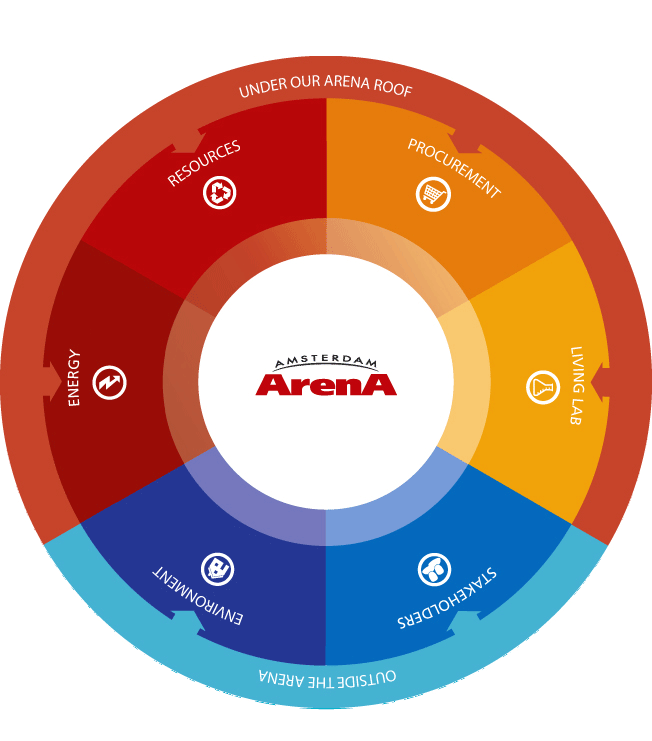Coca-Cola Enterprises:
Building Bridges between Different Interests
“At Coca-Cola, sustainability is a core value of the organisation. And so it should be. Sustainability is essential for a healthy and profitable future of our company,” says Olaf van der Ham, Senior Manager Shopper Marketing at Coca-Cola Enterprises. “Furthermore, a company like ours is expected to have an ambitious sustainability programme. We want to make a difference throughout the value chain. To achieve this, cooperation is vital.”
Being a major player in its market, Coca-Cola encourages other parties in the value chain to make sustainable choices. “Packaging, like drinking cups, is necessary to bring our product to the consumer. We try to make the impact of packaging on the environment as small as possible. That is why we want all our packaging – tin, glass, paper, PET – to be made of either recycled or plant-based materials by 2020. We also want to recycle more packaging out of the market, than we release into the market.
Sharing Knowledge and Expertise
To make sustainability a focal point at an event like Sensation, joint support is a necessity according to Van der Ham. “Commitment is the oil in the machine. It enables you to build bridges at times when you are dealing with conflicting interests. Pushing others around from a position of power does not work. You in fact need each other because every party has valuable knowledge and expertise. For instance, ID&T has the best insight into the visitors at the event, while the ArenA communicates intensively with the company that recycles used drinking cups. You have to work together, focused on a single objective.
Leadership and Transparency
Nevertheless, van der Ham sees the need for a clear leader, who can take charge of the process. “A party that creates an atmosphere of openness and transparency regarding the individual roles, effort required and commercial contacts. For example, it only makes sense for us to deliver recyclable packaging if in the end this packaging is in fact recycled correctly. The central player, in this case ID&T, needs to map the entire supply chain and get the necessary commitment from every party involved. In this type of cooperation, we are happy to act as one of the leading parties to facilitate, motivate and show that it can be done.”
ID&T:
‘Closing the Plastic Loop’ is a Challenge for the Entire Chain
ID&T’s ambition is to be a sustainable leader in the event industry. “We always want to organise the best parties, while keeping people and the environment in mind,” says Jet Hoevenberg, Marketing & Sustainability Manager at ID&T. “For instance by ensuring the waste from an event like Sensation is recycled whenever possible. The drinking cups make up an important part of this waste.”
‘Closing the plastic loop’ is the ambitious objective of Sensation organiser ID&T. Or, to be more precise, closing the plastic recycling loop. Hoevenberg: “Plastic has a high recyclable value, provided you use a single type of recyclable plastic. Our own research showed that PET is the best solution. This type of plastic is highly recyclable without loss in quality. That is why we want all drinks at Sensation to be served in PET-plastic cups that can be returned to us by the visitors. This way we hope to minimise the impact on the environment, as well as creating awareness among our visitors.”
Complex Chain
Introducing a ‘monoflow’ of plastic cups seems a simple objective, but actually involves a complex chain of partnerships, says Hoevenberg. “You need the entire chain to make the process sustainable. It starts with purchasing and setting conditions for all parties involved. Our suppliers do not purchase materials for Sensation only, which takes place once a year. Therefore, our requirement affects other events and their stakeholders. You have to get all the parties to embrace the same objective.”
Green Deal Enables Constructive Dialogue
According to Hoevenberg, the most important task of the initiator, ID&T, is bringing everyone together and supporting them. “We invite everyone to take responsibility and share their expertise. Thanks to the Green Deal partnership, we have already made a significant step towards the best solution. Aspects like pricing are not necessarily a deal breaker anymore. Although price plays a role, it is all about looking for solutions. It’s a big challenge, but thanks to everyone’s commitment we are making progress.”
Catering Club:
Sustainability Should Not Compromise Quality
Being an ArenA partner, the Catering Club has an extraordinary position. “To summarize the situation: if the ArenA makes a left turn, so will we,” says Nicole Pasma, Manager Operations at the Catering Club. “Even so, it must be feasible and fit into our operations. We support the concept of sustainable drinking cups, but you must be able to pour a decent beer into them and soft drinks should not go flat immediately.
The Catering Club caters for most of the 90 events that take place annually in the ArenA. “For us, Sensation is a major event, even though it only takes place once a year. In that sense, ID&T has a big influence on our purchasing policy, including the PET cups.
Solid Investment Plan
Switching to PET requires a lot of effort, says Pasma. “Not just for the Catering Club, but for the entire chain. The procurement of the cups, of which we use over a million annually, is our responsibility. If all the cups have to be changed to PET overnight, we would need to work together to decide who will bear the additional investment.” The ArenA is responsible for the separation and processing of waste. “That is also something you need to consider together. It would be in vain to make an effort at the front end that does not result in an improvement further down the chain.”
Many Initiatives
“Besides the cups, we also contribute to a lower environmental impact by separating glass and cardboard, and by using condiment sauce pumps (mayonnaise, ketchup, etc.) during Sensation, instead of single-serving packaging. We also offer organic and Fair Trade food. Snacks that were previously presented in a plastic tray are now served on a napkin.”
Sharing Costs as well as Revenues
Striving for sustainability is a complex process, according to Pasma: “We want to do everything to make our catering sustainable, but are dependant on our partners as well as the supply chain. As a partner, we would appreciate more incentive to continue striving towards sustainability. By linking the percentage of the fee, that we as the catering partner pay the ArenA, to the additional costs involved in providing organic or sustainable products, for instance. Or by sharing the experience and successes we realise together.”
Amsterdam ArenA:
Sustainability is a ‘Balancing Act’ between the Involved Parties
The Amsterdam ArenA initiated Green Deals: agreements in relation to the shared ambition to make the ArenA more sustainable. From this perspective, the most important role in the sustainable cups project is mediating between all involved parties. “It is a balancing act between ID&T, the various suppliers and our caterer,” says Josine Rienks, intermediary Customer Insights at the ArenA.
Merely purchasing a sustainable cup is not enough according to Rienks. “Waste processing – which is our responsibility – also has to be done correctly. Unfortunately, after such an event there are not just cups scattered over the field, but also personal items like shoes and shirts for example. If you want to separate this properly, it has to be done by hand. We also need to place additional litter bins; the one hundred bins usually placed around the concourses of the ArenA are sufficient for football matches, but not for an event like Sensation.”
The Right Moment
The extra bins needed to separate the waste require a considerable investment. “And the improved sustainability will not bring a full return on the investment,” says Rienks. “It is not that we view the rewards only financially. The awareness of the visitors, the learning process and the reduced environmental impact are all valuable gains. Nevertheless, you do have to find the right moment for this type of investment because there are many other sustainable initiatives on our priority list.”
Naturally Sustainable
What ID&T wants to achieve is not impossible, according to Rienks. “The challenge for the ArenA is to have the cups used and recycled at all events, including the Ajax matches. That makes it operationally and financially viable. If we only apply this to Sensation, then the threshold becomes very high.” That is why Rienks considers it vital for initiator and leading party, ID&T, to encourage or even demand the use of PET cups by all its partners. “At times a sponsor’s interests conflict with sustainability. Only by overcoming these barriers together and creating a level playing field across the event industry, sustainability will become a naturally integrated factor.”







